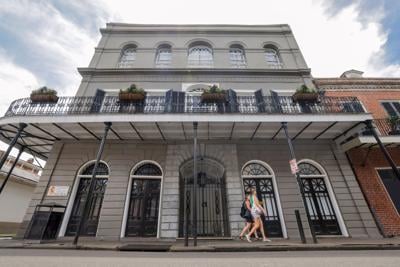On the corner of Royal and Governor Nicholls streets stands an infamous three-story antebellum estate that has captivated millions of tourists, film crews and even a Hollywood actor.
The Empire-style mansion, at 1140 Royal Street in New Orleans, was originally home to Delphine Macarty LaLaurie and is known as one of the most haunted properties in the city. The wealthy socialite was called a "demon in the shape of a woman" and allegedly tortured enslaved people while she owned the home.
Since its creation in 1831, the LaLaurie Mansion has been reincarnated over the years, constantly finding a new purpose in the French Quarter. The residence is a pinnacle attraction in city tourism, satisfying out-of-towners eager to consume New Orleans' ghost stories. It was briefly owned by Oscar-winning actor Nicholas Cage before he lost it to foreclosure in 2009.
The property's sinister history even inspired the third season of the horror-drama television series "American Horror Story."
Now, it's back on the market for $10.25 million after being recently owned by Houston-based energy trader Michael Whalen.
A fire at a New Orleans mansion
The real estate listing photos for the LaLaurie mansion show a beautiful estate with colorful rooms adorned with antique furniture and some modern touches. But some who know the told history of the property questioned how anyone could live there for even one hour in a viral Facebook post.
The mansion was owned by the socialite and her third husband, Dr. Louis LaLaurie.
Rumors had long circulated that LaLaurie tortured slaves, but the horrific abuse was not brought to light until the mansion caught fire on April 10, 1834. According to the New Orleans Bee, several people asked to take the keys and enter the home, but were rejected in a "gross and insulting manner."

Madame Delphine LaLaurie née MacCarthy, circa 1830, copper and wood printing block by an unknown artist.
The unknown reporter of this story did not specify if it was LaLaurie or her husband who refused to give up the keys.
Once people were able to enter the house, they witnessed "seven slaves more or less horribly mutilated...suspended by the neck, with their limbs apparently stretched and torn from one extremity to the other," the reporter wrote.
The story added that the victims "had been merely kept in existence to prolong their sufferings and to make them taste all that the most refined cruelty could inflict."
After the fire, people raided and demolished LaLaurie's mansion, destroying "everything upon which they could lay their hands on."
While oral tradition says that the slaves died in the fire, the New Orleans Bee reporter did not confirm that in the report.
Another account
In 1838, author Harriet Martineau shared details about LaLaurie and the house fire in volume two of "Retrospect of Western Travel," a book about American social and economic conditions at that time.
During her visit in New Orleans, unnamed sources told Martineau that other locals were suspicious of LaLaurie's treatment toward the slaves. However, they didn't question it further because of her outward appearance of charm, hospitality and "perfect goodness," the book said.
Marineau wrote that a next-door neighbor, whose name was not specified, once saw LaLaurie with a whip as she allegedly chased a child outside of the house, until they reached the very top of the estate.
The neighbor covered her eyes right before the girl fell from the top of the house. After the child landed, it appeared "as if every bone was broken," Marineau wrote.
The book said that the child's body was buried at the corner of the yard.
In regards to the 1884 fire, Marineau said that a slave tied to the stove started it after declaring that "they had better all be burned together than lead such a life."
Marineau wrote that the people who entered LaLaurie's home saw seven starved slaves, two of which died later that day.
After being met by enraged crowds outside of her destroyed home, the book said that LaLaurie escaped to Paris, where she went by another name.
A 'haunted' mansion?
Cage and Whalen are the two most recent owners of the LaLaurie mansion.
The Oscar-winning actor told Vanity Fair in 2014 that he bought the house in 2007 with the intention of writing an American horror novel there. However, Cage didn't get very far in his book.
In a recent interview with The Wall Street Journal, Whalen did not share any experiences relating to his former home being haunted.
“I’m Catholic, and that kind of stuff doesn’t scare me,” he said.
The Journal said that when Whalen moved in, he had the LaLaurie Mansion blessed by a priest.



